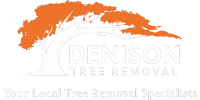Tree trimming is essential to keeping your landscape vibrant, especially in areas like Ledyard, CT and nearby towns such as Preston, Waterford, Stonington, and East Lyme. However, improper techniques can do more harm than good. Whether you’re maintaining your backyard trees or ensuring safety near your property, understanding what not to do is just as important as knowing what to do. At Denison Tree Removal, we deeply care about your trees’ health and offer expert tree trimming services to help our local communities thrive.
Key Takeaway: Trimming trees incorrectly can lead to disease, decay, and reduced lifespan. Avoiding common mistakes ensures your trees stay healthy and beautiful.
Understanding When and How Much to Trim
Over-Pruning Can Damage Tree Health
One of the biggest mistakes homeowners in Preston, CT make is over-pruning. Removing too many branches, especially during one season, can stress the tree. This reduces the tree’s ability to produce energy through photosynthesis, which can lead to poor growth and increased vulnerability to pests and diseases. Referencing Tree Health highlights how crucial a balanced canopy is to a tree’s well-being.
Ignoring the Seasonal Timing
Not all seasons are ideal for trimming. For residents seeking Tree Trimming in Waterford, CT, understanding the tree’s growth cycle is critical. Late winter or early spring is often best as trees are dormant, reducing stress. Improper timing, especially in fall, can expose your trees to fungal infections.
Incorrect Cutting Techniques
Using dull tools or making improper cuts can leave your trees open to disease and decay. Cutting too close or leaving stubs damages the branch collar, a vital part of the tree. This is why Arboriculture stresses proper trimming methods that prevent wounds from becoming entry points for pests.
Avoiding Dangerous Practices
Topping Trees Weakens Their Structure
“Tree topping,” or cutting large branches down to stubs, is a harmful practice. Especially for those seeking Tree Trimming in Stonington, CT, avoiding this mistake can protect the tree’s natural shape and health. Tree Topping reduces leaf production and leads to weak, poorly attached new growth.
Neglecting Safety and Surroundings
For property owners in East Lyme, CT, trimming without assessing the surroundings can be dangerous. Power lines, nearby structures, and neighboring trees all pose hazards. Working with a professional like Denison Tree Removal ensures the job is done safely and correctly.
Failing to Remove Dead or Diseased Wood
Ignoring dead or diseased branches invites pests and decay. For those in need of Tree Pruning in North Stonington, CT, removing problematic wood is essential. This prevents diseases from spreading and keeps your trees looking neat and healthy.
Considering Soil and Tree Nutrition
Ignoring Soil Health
Healthy trees need healthy soil. Residents investing in Tree Removal in Waterford, CT often forget to test and condition soil after a tree is removed. Using Soil Conditioner improves soil structure and helps new plantings thrive.
Skipping Fertilization
Proper nutrition ensures trees recover quickly after trimming. Incorporating insights from Fertilizer Trees and Plant Nutrition helps homeowners in Preston, CT keep trees strong and vibrant.
Overlooking Pest Management
After trimming, trees can become vulnerable to pests such as Woodboring Beetles. Implementing proactive Pest Control in places like Stonington, CT is crucial for protecting trimmed trees.
Professional Help Ensures Healthy Trees
Certified Arborists Know Best
Certified professionals understand the science behind healthy trees. Choosing experts like Denison Tree Removal for Tree Removal in East Lyme, CT guarantees proper techniques are followed. Certified Arborists are trained to assess trees and make informed trimming decisions.
Avoid DIY Mistakes
While it may be tempting to trim trees yourself in Waterford, CT, DIY methods often lead to long-term damage. From improper cuts to poor timing, working with experienced professionals ensures lasting tree health.
Regular Maintenance Is Key
Trees require ongoing care. Residents in Preston, CT should prioritize annual inspections and routine trimming. Leveraging a Tree Inventory and regular Tree Testing helps identify issues early and maintain tree vitality.
Answering Common Questions
What is the best time of year to trim trees in Ledyard, CT?
Late winter to early spring is ideal because trees are dormant and less likely to experience stress. This period allows for clean cuts and faster healing.
Can improper trimming kill a tree?
Yes. Over-pruning, poor cutting techniques, and topping can seriously harm or even kill a tree over time by disrupting its natural growth patterns.
Should I hire a professional tree trimming company?
Absolutely. Hiring a trusted company like Denison Tree Removal ensures the job is done safely and according to industry standards, protecting your investment and landscape.
Why Soil Conditions Matter
Healthy soil supports root development and overall tree health. After a Tree Removal in North Stonington, CT, rejuvenating the soil with conditioners and regular testing fosters new growth.
The Role of Pests in Tree Decline
After trimming, trees may be vulnerable to pests. Utilizing proactive pest control methods can prevent infestations and keep trees in East Lyme, CT thriving.
Trust Denison Tree Removal for Expert Tree Care
If you’re uncertain about trimming or pruning, or simply want the best care for your trees, trust Denison Tree Removal. Whether it’s routine maintenance or specialized services like Stump Removal in Preston, CT, our team is ready to help. View examples of our work in our Gallery and get in touch through our Contact Page.
Keep your trees healthy and your property beautiful. Reach out to Denison Tree Removal today and experience the caring, expert service your landscape deserves.

